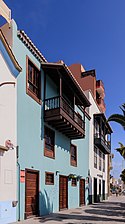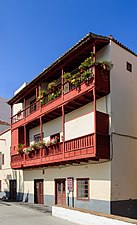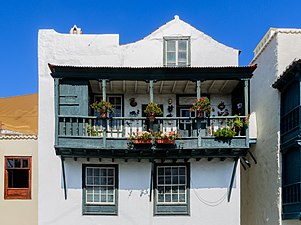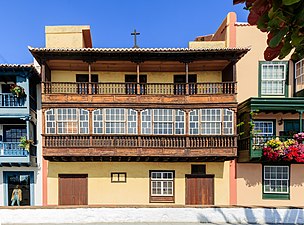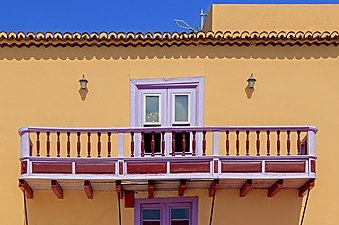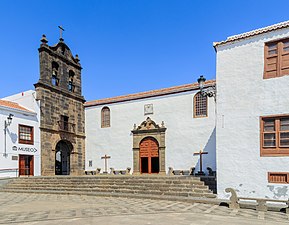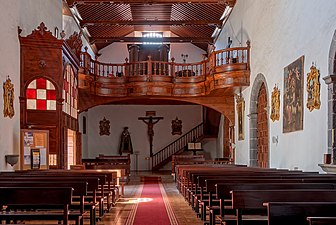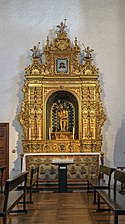Santa Cruz de La Palma
| Santa Cruz de La Palma municipality | ||
|---|---|---|
| coat of arms | Map of the Canary Islands | |

|
|
|
| Basic data | ||
| Autonomous Community : | Canary Islands | |
| Province : | Santa Cruz de Tenerife | |
| Coordinates | 28 ° 41 ′ N , 17 ° 46 ′ W | |
| Height : | 4 msnm | |
| Area : | 43.38 km² | |
| Residents : | 15,716 (Jan 1, 2019) | |
| Population density : | 362.29 inhabitants / km² | |
| Postal code : | 38700 | |
| Municipality number ( INE ): | 38037 | |
| administration | ||
| Website : | www.santacruzdelapalma.es | |
| Location of the municipality | ||

|
||
Santa Cruz de La Palma is the capital of the Canary Island of La Palma and a municipality. 15,711 people live in the capital itself (as of January 1, 2016) .
The parish lies below the wooded slopes of the Cumbres ( Cumbre Nueva and Cumbre Vieja ) on the eastern side of the island. A narrow strip of shore stretches between the coast and Cumbres, so the white houses stretch out on the mountain slopes. All administrative facilities of La Palma are concentrated in Santa Cruz de La Palma.
Cityscape
The old town of Santa Cruz has been declared an art historical monument . The main thoroughfare is Avenida Maritima , the embankment road that is only built on the land side. In addition to new buildings, there are some old houses in the Canarian and colonial style with artistically decorated wooden balconies. The parallel Calle O'Daly , also known as Calle Real, is home to the town hall (built in the 16th century under the reign of Philip II ), the Plaza de España with the main church of El Salvador , small shops, cafeterias and restaurants .
The city beach, which was opened in 2017, extends on the sea side of Avenida Maritima .
history
founding
In the first half of the first millennium BC, when the first groups of settlers came from North Africa, the first settlement of people in the former Tedote district began . In some of the landmarks such as the caves of the Morro de Las Nieves mountain , their presence is evidenced by cave paintings, canals, crucibles and the former meeting place La Erita with over 300 petroglyphs, located about 2000 meters above the community .
Santa Cruz de La Palma was founded on May 3rd, 1493, the day of the elevation of the Holy Cross , by Alonso Fernández de Lugo in the place where the old Canarian settlement Apunyon (also Apurón) was. After this conquest, Santa Cruz was under the crown of Castile . Since then, the city has gradually gained more and more economic importance. The trade routes to Europe and America in particular were so important that the first overseas court was set up at the port of Santa Cruz in 1558.
Pirate raids
The prosperity of Santa Cruz de La Palma, where there was plenty of sugar and later wine stored in the trading houses and where ships loaded with American gold and silver anchored in the harbor, naturally also aroused great interest among pirates and the pirates of other seafaring nations, who were equipped with royal letters of promise. The port city was attacked for the first time in 1537. But one was prepared and could put the French corsairs to flight. In 1553 François Le Clerc , known as Holzbein , attacked Santa Cruz with a fleet of eight ships. This time it was easy for the attackers, they plundered the city and set everything they could not take with them and the city itself on fire. After this disaster, more defenses were built, batteries and gun emplacements were built around the island. In view of this artillery shield, all further pirate and corsair attacks failed. In 1585 the Englishman Francis Drake , who was advancing with about 30 ships, was forced to turn back while at sea by gunfire; It was no different for one of his compatriots and privateers from Algeria and the Netherlands .
America trade
La Palma did not only prosper through sugar and wine . Thanks to its geographical location, the island was also able to benefit from the American trade. In 1508 the Canary Islands had the privilege of practically free movement of goods. Almost every ship that operated between the Spanish mainland and the American colonies made a stopover in the Canaries, especially on La Palma, the most north-western island. In 1556, the Spanish King Philip II gave the Palmerian capital Santa Cruz not only the nickname of high noble and loyal Villa de la Cruz , but also the privilege of trading in new properties overseas on his own account. The port city soon assumed a leading position in shipbuilding too. The first shipbuilders settled on the island, which was favored by the abundance of wood in the forests, immediately after the conquest. More than 120 frigates and caravels were launched in the 16th century. In the first half of the 17th century, Santa Cruz de La Palma was the third largest port in the Spanish Empire after Seville and Antwerp . The economic decline began in 1657. According to a decree, all ships on their way to America had to be registered on Tenerife and pay their duties there. The trade in the port of Santa Cruz de La Palma almost came to a standstill. Although King Carlos III. 1778 free the America trade for all Spanish ports, but Santa Cruz de La Palma could never fully recover from the economic crisis. The commercial metropolis of the cosmopolitan became the tranquil colonial city of today.
traffic
A few kilometers south of the capital is the Santa Cruz de La Palma airport , which opened in 1970 and is currently being expanded . National charter flights and regional scheduled flights to the other islands of the archipelago are handled here.
A fast ferry on the Fred shipping line serves daily . Olsen Express the route Santa Cruz de La Palma - Los Cristianos (South Tenerife ) with a stop in La Gomera in about three hours. The Spanish state shipping company Compañía Trasmediterránea operates between Cádiz (mainland Spain ) and Santa Cruz de La Palma, with stops in Lanzarote , Gran Canaria and Tenerife, once a week. Another ferry is operated by the Naviera Armas company.
The commercial port is economically very important for La Palma. There is also a heavy oil power plant here, which receives fuel from tankers.
Attractions
The city's attractions include a .:
- Balcones de la Avenida Maritima , the best preserved ensemble of typical Canarian wooden balconies.
- Renaissance town hall from the 16th century with a wooden coffered ceiling and wall paintings about the life of the islanders in the Plaza de Espana .
- In the middle of the Plaza de España is the bronze statue of Pastor Manuel Hernández Díaz, erected in 1895 . He campaigned for a liberal constitution for Spain from 1820 and opened a free school for children of all classes.
- Iglesia Matriz de El Salvador , built at the beginning of the 16th century in three naves with coffered ceilings in the Mudéjares style and an attached tower made of ashlar stones of volcanic origin in the Plaza de España .
- Iglesia Santo Domingo was built in the 16th century together with the former Dominican monastery of San Miguel de las Victorias as a three-aisled church with a wooden ceiling construction in the Andalusian-Moorish Mudejar style. Inside it houses a comprehensive collection of Flemish oil paintings. The church's bell tower was built in 1701.
- Iglesia de San Francisco, built in the Renaissance style, once belonged to the Franciscan monastery Real Convento de la Inmaculada Concepción . The Señor de la Piedra fría chapel, built in 1565, has an octagonal domed vault with a Mudejar ceiling above its square floor plan. Today the monastery is the seat of the island museum Convento de San Francisco with works of art such as the Flemish sculptural group Santa Ana , the Virgin and Child (16th century), carved figure from Seville (18th century).
- Ermita de La Luz / de San Telmo was built in 1574 by the Brotherhood of Sailors in Santa Cruz and consecrated to San Pedro González Telmo , the patron saint of sailors. The chapel - as it exists today - was rebuilt between 1675 and 1680 with donations from the fishermen. The chapel is located in the upper town above the harbor and acts like a watchtower over the incoming ships.
- Ermita de La Encarnación is located at the northern exit of the city and is the second church on the island, built around 1493 after that of San Miguel Arcángel in Tazacorte . The church houses the Flemish sculpture The Annunciation (16th century) and a group of sculptures made of polychrome wood from Flanders .
- Teatro Circo de Marte : The building, not far from the Santo Domingo Church, was built in 1624 and used as a theater from 1864. In 2008 it was completely restored.
- Castillo de Santa Catalina was built in 1692 from black lava rock based on a design by the Italian builder Leonardo Torriani in 1585 . The fortress was used for military purposes until 1808 and also served as a barracks and prison. It was declared a national historical monument by decree on June 22, 1951.
- Santa Maria ( Barco de la Virgen ), a full-size replica of the caravel with which Christopher Columbus discovered America, is located in the Plaza de La Alameda in Santa Cruz. In 1765 it was first made of wood and stone and in 1940 for the Bajada de la Virgen de las Nieves in concrete. It is considered a symbol of La Palma. The Maritime Museum, Museo Naval, has been located in the ship since 1975 .
gallery
Fiestas
The Bajada de la Virgen de las Nieves is one of the outstanding festivals in La Palma. In order to avert an impending crop failure, the Canarian Bishop Jimenez once ordered the statue of the Virgin of the Snow (Virgen de las Nieves), the patron saint of La Palma, to be carried in a procession from Las Nieves to the capital. Nowadays, the procession is repeated every five years, in the 0s and 5s. The festivities drag on for more than a month each summer.
Another highlight of the celebrations is the carnival, whose parades and events are reminiscent of the South American carnival. On Carnival Monday ( Día de Los Indianos ), the “return of the emigrants” is celebrated in Santa Cruz. The Palmeros then dress completely in white, as a parody of those who came to prosperity in Latin America at the time, and throw baby powder around them.
Since 2015 the Festival Internacional de la Música has been taking place in June and July with international soloists and chamber music ensembles.
Places of the community
The population figures in brackets are from 2013.
- Santa Cruz de La Palma (13,250)
- Miranda (1,054)
- Lomo del Centro (235)
- Velhoco (151)
- Juan Mayor (181)
- Cuesta del Llano de la Cruz (198)
- Lomo Espanta (147)
- Los Alamos (133)
- El Planto (120)
- Las Tierritas (114)
- Llano Grande (102)
- El Pocito (105)
- Las Toscas (63)
- El Morro (54)
- Roque de Arriba (82)
- Barranco del Rio (39)
- Barranco de la Madera (77)
- La Verada (57)
- La Portada (64)
- Candelaria (56)
- Las Nieves (16)
- Lomo de los Gomeros (9)
- El Dorador (9)
- El Fronton (5)
- Las Lajitas (9)
sons and daughters of the town
- Hermenegildo Rodríguez Méndez (1870–1922), Spanish playwright
- Domingo Acosta Guión (1884–1959), Spanish journalist and poet
- Manolo Blahnik (* 1942), Spanish shoe designer
- José García y Más (* 1945), Spanish painter
- Antonio Tabares (* 1973), Spanish playwright
- Pablo Konrad y Ruopp (* 1991), German actor
Population development
Santa Cruz experienced the greatest growth in the 1930s and 1970s. Since the turn of the millennium, the population has been declining, contrary to the trend for urban areas in La Palma.
|
|
gallery
Web links
Individual evidence
- ↑ Cifras oficiales de población resultantes de la revisión del Padrón municipal a 1 de enero . Population statistics from the Instituto Nacional de Estadística (population update).
- ↑ Consejería de Turismo, Cultura y Deportes: Santa Cruz de La Palma. Bienes de Interés Cultural. Gobierno de Canarias, accessed May 1, 2019 .
- ↑ The partly contradicting sources for the two raids in 1553 and 1585 are presented by Pedro N. Leal Cruz: Los ataques piráticos de Pie de Palo (1553) y Francis Drake (1585) a Santa Cruz de la Palma. Análisis contrastivo. In: Memoria digital de Canarias .
- ↑ a b Rolf Goetz: La Palma, active vacation on the greenest of the Canary Islands. 5th edition. Peter Meyer travel guide, Frankfurt am Main 2000.
- ↑ Santa Cruz de La Palma , Palmeros en El Mundo.
- ↑ a b c La Palma - excursions Santa Cruz
- ^ Iglesia de El Salvador , Turespaña, Ministry of Tourism.
- ↑ Iglesia de Santo Domingo , Ayuntamiento de Santa Cruz de La Palma.
- ↑ Iglesia de San Francisco , Ayntamiento de Santa Cruz, La Palma.









